#fruitbody
Explore tagged Tumblr posts
Text
"Fruitbodies?" What is that, some kinda gay alphabet-people word?
3 notes
·
View notes
Text

Ramaria araiospora
“A fruitbody of the coral fungus Ramaria araiospora Marr & D.E. Stuntz. Photographed in Jackson Demonstration State Forest, Mendocino Co., California, USA.” - via Wikimedia Commons
#Ramaria araiospora#red coral#fruiting body#coral fungi#coral fungus#coral mushroom#red coral mushroom#edible mushrooms#eukaryotes#fungi#basidiomycota#agaricomycetes#gomphales#Gomphaceae#mycology#mushroom#mushrooms#mushroom foraging#fungus#wild fungi#fungi photography#fungicore#fungi aesthetic#fantastic fungi#forestcore#forest aesthetic#wikipedia#wikipedia pictures#wikimedia commons#nature
264 notes
·
View notes
Text
Bioluminescent Mushrooms
This post will discuss four species of bioluminescent mushrooms, all of which are gorgeous and fascinating. Some of these species will be rather rare and elusive, while others will be more widespread and might be familiar to you.
A/N: Because this is a longer post discussing multiple species, I will focus solely on the spores under "Spores and Microscopic Features".
@rainbow-nigthmare I hope you like it :DD
@squidsandthings, @fungus-gnats, @fairy-tales-of-yesterday, @jatropha, @lameotello, @lovelyalicorn, @writingraccoon, @edukincon, you might also find this interesting <333
Little Ping-Pong Bats - Panellus pusillus


On the left: Panellus pusillus on a log . On the right: Panellus pusillus on a log, displaying bioluminescence.
Fruitbody
Little ping-pong bats are, as the name implies, very tiny fungi. The kidney-shaped caps measure up to 15 millimetres and are cream to white.
On the underside of the cap, the cream coloured pores appear large for the size of the fruit-body. It has about three pores per millimetre.
A small disc attaches the stem to the substrate, which is often some form of rotting wood.
Spores and Microscopic Features
The spores measure 35 × 1.52 µm and are ellipsoidal, smooth and generally colourless, but will appear white in mass.
Ecology and Distribution
Panellus pusillus can be found on living and dead trunks, fallen logs and branches of eucalyptus trees, or other species of trees in forests. On the wood, it appears in large groups, with overlapping caps.
It is a widely distributed species. Namely, it has been recorded in Australia, Asia, Europe, North America, and South America.
Eternal Light Mushroom - Mycena luxaeterna


Two pictures above: Mycena luxaeterna on a log, displaying bioluminescence.
Fruitbody
Mycena luxaeterna's cap is parachute-shaped, and grows up to 2 centimetres in diameter. Initially, the caps are dark greyish-brown, changing to greyish-yellow or pale greyish-brown with a pale white ring at the edge as they mature. The gills are attached to the stem.
Their thin, cylindrical, hollow, fragile stipes reach up to 8 millimetres in diameter. These stipes are enveloped in a thick gel and emit a constant yellow-green bioluminescence.
The mushroom has a slightly radish-like smell and a similar, somewhat bitter taste.
Ecology and Distribution
The eternal light mushroom was discovered in a small and limited area of the Atlantic rain forest in São Paulo, Brazil. It is known to exist only at this location. It grows on decomposing twigs, rarely on dead leaves or undergrowth, and in clusters of two to twenty individuals.

Jack-O'-Lantern Mushroom - Omphalotus olearius


On the left: Omphalotus olearius on a log. On the right: gills of Omphalotus olearius, displaying bioluminescence.
Fruitbody
Omphalotus olearius' cap measures between 4 and 20 centimetres in diameter and is bright brownish orange to yellowish orange in colour. Initially, it is broadly convex with the margin slightly inrolled, but quickly becomes shallowly to moderately depressed. It is bald, and dry or faintly greasy.
The gills are decurrent, meaning they run down the stem and have the same colour as the cap and luminescent when fresh.
The stipe is 3.5 to 14 centimetres long, and 1 to 2.5 centimetres thick in diameter. The stipe tapers towards the base, has a solid texture and a bald surface.
The flesh is pale orange, and does not change colour when sliced.
Spores and Microscopic Features
The spore print is whitish, being creamy white to yellow.
The spores are 5–7 x 4–6.5 µm, sublacrymoid to subglobose, smooth, and hyaline to yellowish in KOH.
Ecology and Distribution
The Jack-o'-lantern mushroom is saprobic; growing in large clusters on the stumps or buried roots of hardwoods, especially olive trees and oaks. They grow during the late summer and fall.
They are distributed in central and southern Europe, especially along the Mediterranean coast.
Toxicity
This mushroom and other members of the genus Omphalotus are seriously poisonous mushrooms that contain the toxin muscarine. When consumed, muscarine causes gastric upsets that can last for several days.
Bitter Oyster - Panellus stipticus


On the left: gills of Panellus stipticus, covered in water droplets. On the right: gills of Panellus stipticus, displaying biolumenescence.
Fruitbody
The cap of Panellus stipticus is 5 to 30 millimetres across, convex in shape with an inrolled margin, becoming planoconvex with the margin even or slightly curved under. In outline, it is semicircular to kidney-shaped. The surface is dry, finely velvety to woolly, and often becomes wrinkled and somewhat scaly as they mature. It is tan to pale yellowish-brown or orangish-brown, sometimes fading to off-white as they age.
The gills are pale tan, crowded, forked, and usually have strong cross veins, which gives a reticulate appearance.
The stipe is eccentrically or laterally attached, tapering towards the substrate. It is 3 to 7 millimetres in diameter and 0,3 to 2 centimetres long. It is tan to buff in colour, and covered with longitudinal silky fibrils. Further, it does not display a ring.
The white to pale brown flesh is known to have a tough texture.
Spores and Microscopic Features
The spore print of the bitter oyster is white.
The spores are 2.5–5 x 1.5–3 µm, ellipsoid to suballantoid, smooth, hyaline in KOH, and amyloid.
Ecology and Distribution
Panellus stipticus is saprobic on the deadwood of hardwoods, particularly oaks, usually growing in shelving clusters. It grows from spring through fall, but might also overwinter in warm climates, or during winter warm spells in temperate areas.
It is widespread in Europe, but also distributed in Anatolia, Asia, Oceania, and the Americas. In North America, it is more common in the east than the west, where the mushroom's northern range extends to Alaska, and it has been collected as far south as Costa Rica.
~~~~~~~~~~~~~~~~~~~~~~~~~~~~~~~~~~~~~~~~~
Image sources:
Little Ping-Pong Bats - Panellus pusillus
https://www.inaturalist.org/observations/216151176
Eternal Light Mushroom - Mycena luxaeterna
https://www.inaturalist.org/observations/103964610
https://en.wikipedia.org/wiki/Mycena_luxaeterna#/media/File:SaoPaulo_Municip_Iporanga.svg
Jack-O'-Lantern Mushroom - Omphalotus olearius
https://www.inaturalist.org/observations/252742924
https://www.zmescience.com/science/biology/poisonous-mushroom-glow-dark
Bitter Oyster - Panellus stipticus
https://www.inaturalist.org/observations/64055068
https://www.inaturalist.org/observations/90689615
~~~~~~~~~~~~~~~~~~~~~~~~~~~~~~~~~~~~~~~~~
Little Ping-Pong Bats - Panellus pusillus
https://www.elfram.com/fungi/fungi_o/panpus_a.html
https://fungimap.org.au/dictyopanus-pusillus-little-ping-pong-bat
https://en.wikipedia.org/wiki/Panellus_pusillus
https://keys.lucidcentral.org/keys/v4/101-forest-fungi/web/resource/d/dictyopanus%20pusillus.htm#:~:text=Contents&text=Common%20name:%20None.,on%20either%20bark%20or%20wood.
Eternal Light Mushroom - Mycena luxaeterna
Desjardin, Dennis E.; Brian A. Perry; D. Jean Lodge; Cassius V. Stevani; Eiji Nagasawa (2010). "Luminescent Mycena: new and noteworthy species". Mycologia. 102 (2). Lawrence, KS: The Mycological Society of America: 459–477. doi:10.3852/09-197
https://web.archive.org/web/20210610155141/https://naldc-legacy.nal.usda.gov/naldc/download.xhtml?id=41883&content=PDF
https://en.wikipedia.org/wiki/Mycena_luxaeterna
Jack-O'-Lantern Mushroom - Omphalotus olearius
https://www.mushroomexpert.com/omphalotus_olearius.html
https://www.first-nature.com/fungi/omphalotus-olearius.php
https://en.wikipedia.org/wiki/Omphalotus_olearius
Bitter Oyster - Panellus stipticus
https://www.mushroomexpert.com/panellus_stipticus.html
https://www.first-nature.com/fungi/panellus-stipticus.php
https://en.wikipedia.org/wiki/Panellus_stipticus
#hyperfixation#mycology#Little Ping-Pong Bats#Panellus pusillus#Eternal Light Mushroom#Mycena luxaeterna#Jack-O'-Lantern Mushroom#Omphalotus olearius#Bitter Oyster#Panellus stipticus#mushrooms#fungi#bioluminescence#bioluminescent mushrooms#beloved mutuals#<3
29 notes
·
View notes
Text
FOTD #083 : viscid black earth tongue! (glutinoglossum glutinosum)
the viscid black earth tongue (or glutinous earthtongue) is a saprophytic fungus in the family geoglossaceae. it often grows among moss or in grassy areas :-) it is quite common in the northern hemisphere !!
the big question : can i bite it?? sure - it's edible, but considered "not worth eating". it has been said to be delicious when stewed<3
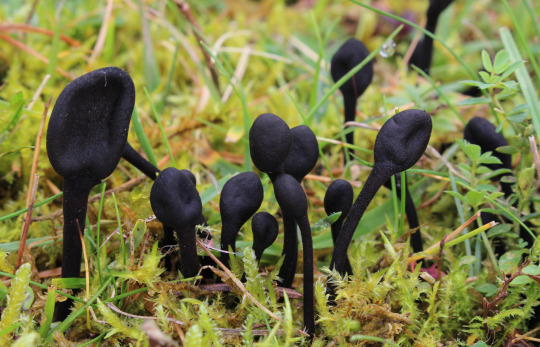
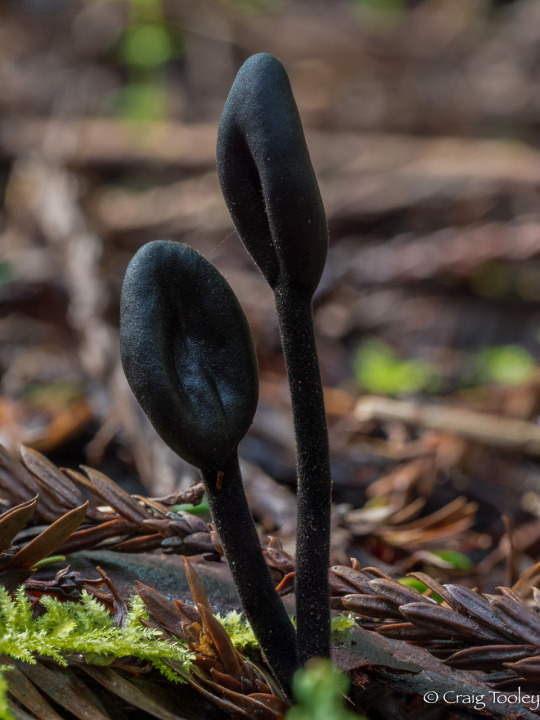
g. glutinosum description :
"the smooth, nearly black, club-shaped fruitbodies grow to heights ranging from 1.5 to 5 cm (0.6 to 2.0 in). the head is up to 0.7 cm (0.3 in) long, & the stipes are sticky."
[images : source & source] [fungus description : source]
#• fungus of the day !! •#[glutinoglossum glutinosum]#: viscid black earth tongue :#: glutinous earthtongue :#083#||#mushrooms#mycology#mushroom#fungus#earth#nature#fungi#cottagecore#forestcore#foraging#fotd#fungus of the day#glutinoglossum glutinosum#viscid black earth tongue#glutinous earthtongue
266 notes
·
View notes
Text
Daldinia concentrica
Commonly referred to as King Alfred's cake, cramp balls, and coal fungus.
The reasons for these names are as follows:
Due to their burnt appearance their common name King Alfreds cake is a reference to the Anglo-Saxon king of England in the 9th century. There is a myth that after being given shelter by a peasant woman Alfred was reputed to have inadvertently allowed her cakes to burn, having promised that he would watch them cooking in return for the shelter.
People used to believe that carrying the fruiting body of one of these mushrooms would cure having cramp, hence the name cramp balls.
The fruiting body is also said to resemble a lump of coal due to its colour and size. The fungi can also be used as tinder for lighting fires, and may have been used as far back as the stoneage!
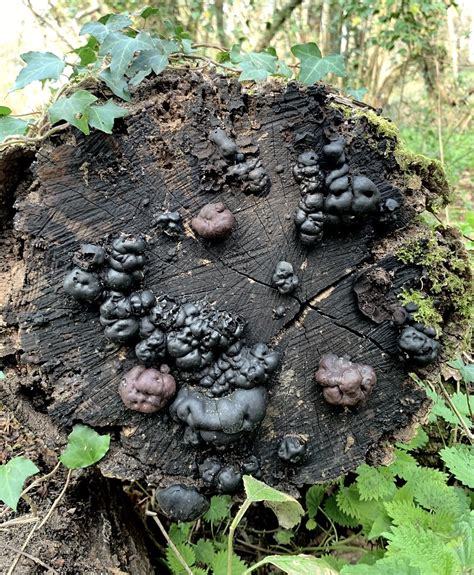

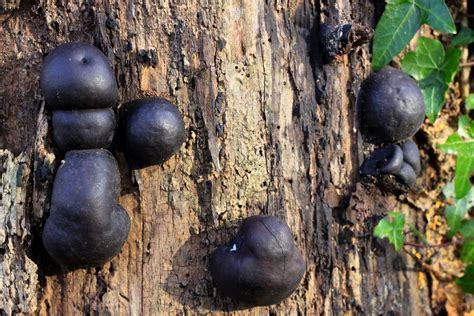
Daldinia concentrica are common in Europe, North America and Australia but they can be found all over the earth in temperate climates. They are found on dead or decaying wood, most often on ash and beech trees.
The fungi is a member of the Daldinia genus this means that inside the fruitbody there are concentric silver/grey and black layers, like tree rings these layers are related to seasonal growth. Many insects and small animals make their homes in the fungus.
Growing members of this species are a pinkish brown, turning black once they are fully grown.
Some examples of young Daldinia concentrica:
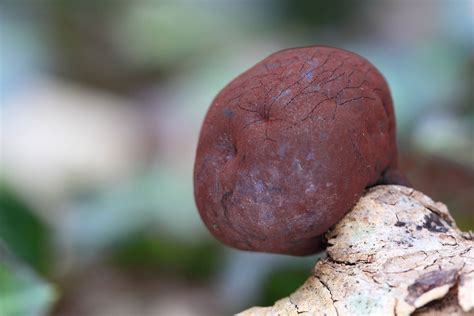
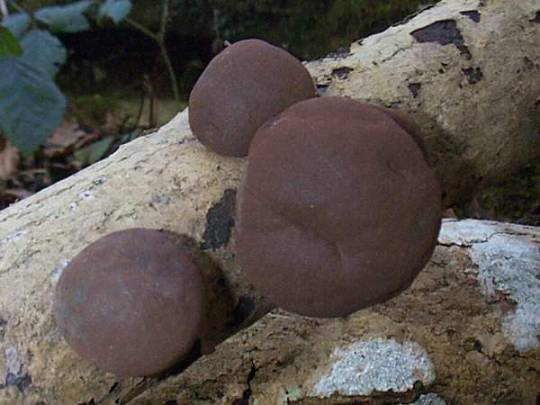
Examples of the rings:
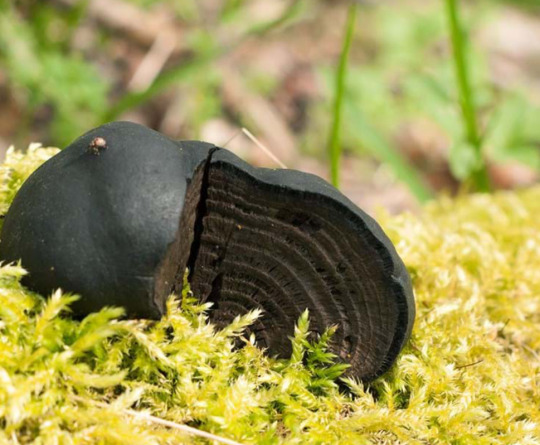

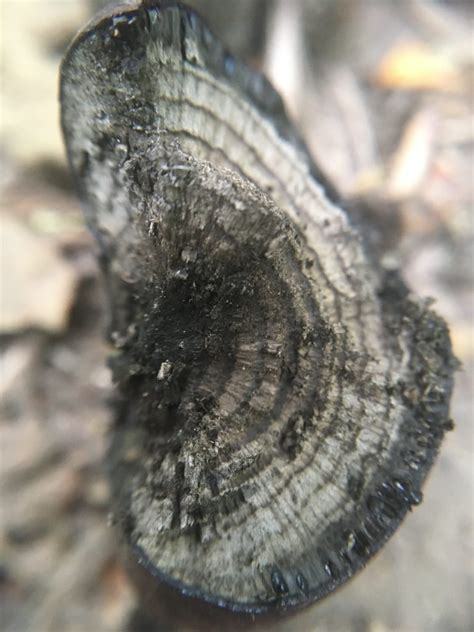
This fungus is inedible.
#Hiii im back#this week went super quick for me#tysm to all the people who have followed me!#Daldinia Genus#soupandmushrooms#fungi#mushrooms#fungus#foraging
23 notes
·
View notes
Note
I saw your tags on the mycology tumblr post - I challenge you to scare me with a mushroom fact. I’ve harvested and eaten wild mushrooms a few times, I’ve got my share of guidebooks and worked on research my university did on suede boletes. I’m no spring chicken of the woods but i’m also far from an expert. Scare me with the Deep Mushroom Lore
Woaaaah this got a bit lost and im a bit late, yikes! Anyway it looks like you were focusing on the Basidiomycota phylum which is where a lot of the frontliners and popular ones are. But let's look at the Ascomycota, lots of scary stuff there, lord there's so much but baseline ig is cordyceps which everyone knows about now. They can alter and control insects, a big example is bullet ant behavior to makes them climb as high as they can and bite onto the grass or whatnot to secure themselves until the host dies. They go as high as possible so when the cordycep actually grows the fruitbody the spores can spread as far as possible. Luckily for us human nervous systems are way too complex for the cordyceps....for now.

I mean any parasite that controls it's host is crazy and I 10000% recommend looking into it.
There's another fungus Laboulbeniomycetes that grows exclusively on arthropod exoskeleton.

A lot of fungal diseases make me shudder, there are probably fungal spores in your lungs right now! Pneumocystis is the genus of a yeast that loves your lungs and you guessed it, causes a strain of pneumonia that's very hard to diagnose! Yippee! Mostly because it is very hard to culture.
Let's look at everyone's favorite yeast Conidida. This guy is DIMORPHIC so it can be a yeast or invasive hyphae depending on environmental triggers/conditions, and wouldn't you know it, lives at human body temp. This guy causes yeast infections and the like.
Aspergillus is one that ferments soy products BUT can also cause Apergillosis which can cause an allergic reaction and eventually a fungal ball growth in your lungs, aak!
In a different phylum, Mucoromycota, Mucormycosis is probably my least favorite as the group USUALLY targets your fruits and is that pesky mold. Well another version of it will target the sinuses of immunocompromized diabetics. These are sugar loving molds so uhhhhh, no bueno. I recommend looking at pictures with CAUTION it is gross. The eyes can get really messed up, black lesions can show up on your face really really nasty stuff.
Anyway, Ascomycota cool group, lots of human diseases (many of which are hard to cure because of how close fungi are to animals so we target very specific things in their cells but OOPS resistance is on the rise), have fun with this info ::)
#mycology#ascomycota really popped off on the diseases#ollie rambles#<<<yea no i RAMBLED#but yea apologies for how late this is been reaaaally busy#long post#call me patient zero the way fungi have consumed my mind
24 notes
·
View notes
Text
Grey spotted amanita, also known as amanita excelsa var. Spissa.

The flat grey-brown cap is covered with irregular pale grey patches from the remains of the veil that enclosed the young fruitbody. The gills are free and white. The stem is white with a transient ring that is grooved on the upper surface. The swollen base has bands of scales but no enclosing sack. Smell of radish.
It's easily confused with poisonous species and so not recommended

2 notes
·
View notes
Text





last update 11/4/23
rajinikanth. 70. cis man. he/him. ┊┊ cerberus corp has been watching KINTAN NAIK. some of the public has dubbed them SAPROPHYTE because of FUNGUS MANIPULATION gifted by EATING SOMETHING HE SHOULDN’T HAVE. having been an extra ordinary since 1969, they’re doing a good job at hiding THAT HIS POWER IS WEAK TO FIRE. when they aren’t working their day job as a PHARMACEUTICAL COMPANY CEO, they are fond of SQUASH and are never seen without GOLD PLATED LIGHTER WITH THE WORDS ‘ALWAYS STAY HUMBLE’ ENGRAVED ON THE SIDE. at first glance they seem CHARMING & GENEROUS, though their underlings know them to also be MELODRAMATIC & ARROGANT. they consider themself a ANTI-HERO. ┊┊
001. GENERAL
name: kintan naik | nicknames: the general | age: 70 | date of birth: 1953 | zodiac answer | place of birth: - | current residence: manhattan | gender: cis man | pronouns: he/him | sexuality: gay | occupation: pharmaceutical company ceo | faceclaim: rajinikanth | height: 5'7" | tattoos: n/a | piercings: both ears
distinguishing features: reverse rogue x-men hair color (white on the sides, black in the center), large glasses, old man swagpositive traits: charming, intelligent, perceptive, friendlynegative traits melodramatic, arrogant, catty, manipulativelabels / tropes: the patriarch, cool old guy, evil old folks, benevolent boss, affluent ascetic, cool old guy, feeling their age, badass in a nice suit, man of wealth and taste, loveable rogue, affably evil. old wind bag, wise old folk facade character inspiration: En (dorohedoro) likes: positive press, being adored dislikes: dips in the stock market, his kids disappointing him fears: being forgotten, death hobbies: the old rich guy classics: squash, golf, sailing, polo habits: smoking, taking off his fashion eye glasses for dramatic effect
002. EXTRA ORDINARY
near death experience…
According to the About Page on his company’s website, Kintan Naik grew up in one of the poorest districts in western India. A born humanitarian, Kintan would fast for days so the other children in the orphanage he grew up in could eat their fill during meals. At age sixteen and desperate to provide for his found family, Kintan fearlessly traveled out into the nearby woods to forage for food. Fortuitously, he was able to find a large collection of mushrooms growing in the shade of a large tree. The dappled light from the sun above obscured the colors of the clusters of mushrooms and in his hunger and excitement, Kintan brought one of the plump, white caps to his lips and took a bite; it was both his greatest mistake and blessing.
In the end Kintan’s NDE allowed him to be able to feed not just his brothers and sisters at the orphanage but the other struggling people around him as well. Community food gardens grew into a thriving mushroom cultivating business that gave both nourishment and employment to the people around him. A born humanitarian, it was a no-brainier that Kintan would become a philanthropist once he accrued a mass of wealth.
Whether this story is one hundred percent true or not is up to debate, but it's not partially advisable that naysayers bring up their issues with Naik or his company in public or forums that can be tied back to them. As if there’s one thing that’s certain is that Kintan Naik has a knack for creating good press and has the sort of good will rarely shown to someone in his tax bracket.
power… [ tw references to/mentions of bodily harm, body horror, gore, mutilation, suffocation ]
Kintan has absolute power over all types of fungi (mushrooms, mold, yeasts) and as such he can force them to rapidly go through their life cycle from spore to sporing in an instant. He can create/connect to mycelium underground networks and use the fruitbodies of mushrooms as wiretap devices.
His ability to manipulate air borne spores into full grown sporing mushrooms means that he can cause mushrooms to grow into a giant cluster. Mushrooms with toxic spores could be used to create poison clouds (Toxic Spore Bomb). And any spores breathed in/ingested could be forced into rapid growth and suffocate or explode someone from the inside out (Rapid Mushroom Growth/Infestation). He is also hypothetically able to make people ill by causing molds/yeast outbreaks in food/body parts.
[ /end of tw ]
drawbacks / vulnerabilities…
His ability works by essentially transferring his own energy into the fungi in question so he cannot grow them indefinitely. Once he becomes exhausted he can no longer use his power and in the case that he tires himself out he would need a couple days to recover. He can also not generate fungi out of thin air, he can only manipulate existing fungi.
As they are organic material, his power is weak to anything that can damage living things but particularly fire.
He's real old. 🤷♂️
The mycelium must be able to reasonably able to connect to each other whether they are rooted into the ground or able to spread far enough to connect to the network.
codename… His marketing team came up with Saprophyte.
003. EXTRA
he has a gaggle of adopted children he's putting through saw-like sociopathic mind games to see which one is best suited to take over the family business once he retires
he is the face of many online memes that may or may not have been the work of his marketing and pr teams
has been time's person of the year
he caries small envelopes/baggies with different mushroom spores for emergency use.
he wears various rings with false gems that also contain spores but for particularly toxic fungi/fungi whose fruitbody grows extremely large (reserved for life-or-death situations).
003. CONNECTIONS:
The Royal Court: Kintan's six children. [ 4/6 roles reserved ] Friends of the Family: SONGSTRESS / HIMIKO YAMADA
The Court Jesters: SAVANT / JAMES SAAB RUBIX / JUNGHYUN HARVEY KWON
#cc.intro#cc.task#(if you see any typos in this no you didn't)#(i forgot to post this ahhhhh)#(will add more later etc etc)
9 notes
·
View notes
Text
MCX Rants: Cloning
r/ContamFam mycopal asks: “Hey pal do you have any good tips or sources for info on moving mushroom tissue to agar?”
MCX Answers: The way I understand it is: you can do two types of transfers for cloning, considered most common and effective.
One is as you mentioned the splitting stipe and taking a transfer from inside the stipe. You want to ensure that your area, yourself, and your tools are cleaned with isopropyl alcohol 70% . You will tear from the base up towards the cap, with the exposed part of the STIPE, towards your laminar flow, or towards the back of your still airbox. you only need a rice size piece of transfer.
Often the inner flesh is very stringy and breaks away quite easily. I’ll personally just cut a rice size cut in a square shape from the inner part of the stipe and then gently poke that and pull it out and put it on a plate. Sometimes inner Mycelium flesh can pull away and you can put that on a plate. The mushroom fruit body is all mycelium. Everything about it is made from mycelium, and arguably all of its components, contain but also can, either: produce or generate, and proliferate mycelium from that fruit body.
The second way involves approaching the xfer from the topside of the cap, ‘dorsal’ and cutting open the center dorsal point and then take from inside the cap at the pileus-stipe junction… but from within the cap… its a little more technical and often can expose the xfer to contam from the flesh u open up before taking xfer if you arent careful in how you peel back the external flesh and when you push the knife into the cap it can push microbes down into the previously unexposed inner mycelial tissue).
The idea for these types of transfers is that contaminants in your environment that float in around you or fall off of you, if present, likely is on or near your external fruitbody. If you take from the inside of the fruitbody its arguable that its more clean and free of contaminant microbes as the primordia formation is assumedly on healthy uncontaminated mycelium and unless the flesh tears during maturation, the inner parts are fully protected from external contaminant sources while growing.
Sometimes these cooccurring microbes are harmless to your grow and to you, and can even be beneficial (like certain yeasts that are used in agar preparation) or even some naturally occurring bacteria in the substrate! I think of my tubs as a homeostatic localized microclimate - environment :)
Our tubs, and the fungi in them have similar homeostasis in the wild, and can be conceptually applied to community mycology cultivation!
I think of comparing potential “microcosm” cultivation much like the human body, external and internal… theres always gonna be contaminant microbes on our skin and around our mucosal membranes, but with proper hygiene and diet our body is its own microcosm of microbes that are fucking and fighting away under our literal noses xD —- its when one grouping of these microbes begins to advantage over the equalized body microcosm we have (think if you dont bathe you may develop yeast and bacterial infections more easily as surface conditions of your skin and within your creases, nooks and crannies will can be overpowered by something that spreads… )
and thats kind of the basic idea of germ theory I think… and I also think it applies to our grow environments if approach cultivation holistically :)
surely im missing technical nuance but I know my thoughts are in the spirit of the theory!
Hope my thoughts aid your mycojourney!
-MCX
Related resources:
- Yoshi Cloning vid and result video
- PGT Cloning Vid
- Ashley/Boomer Shroomer Cloning vid
#mcx#mcx rants#mcx answers#mcxrants#mycology#lgbtqia2s#magic mushies#microbiology#mold#60s psychedelia#lgbtqia#lgbtqia2s+#myc#enby#mushroom#fungus#fungi#queer#non binary#nonbinary
6 notes
·
View notes
Text
Cause fruitbodies are fleshy reproductive organs which grow when two or more mycelia are present in the same place
why do i like the idea of flesh acting like a fungus
3 notes
·
View notes
Text
FOTD #092 : crab of the woods! (laetiporus sulphureus)
the crab of the woods (also sulphur shelf / polypore) is a bracket fungus of the family fomitopsidaceae. it is a saprophyte & weak parasite that often causes brown cubical rot !! it grows across europe & north america :-)
the big question : can i bite it?? yes & it is quite delicious :-) it has been compared to the taste of crab, lobster & chicken. some deer also eat it !! however, humans should not eat it raw.
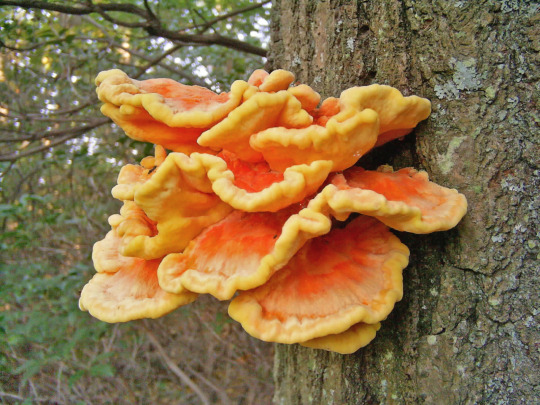
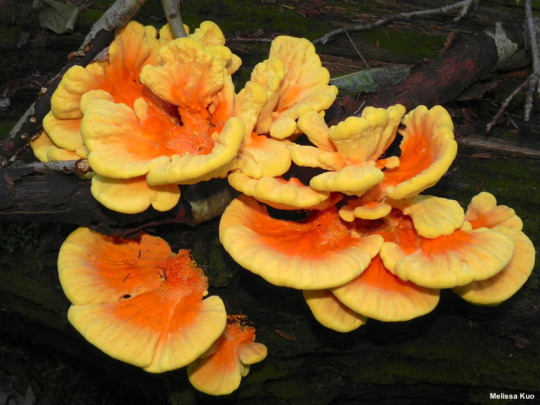
l. sulphureus description :
"the fruiting body emerges directly from the trunk of a tree & is initially knob-shaped, but soon expands to fan-shaped shelves, typically growing in overlapping tiers. it is sulphur-yellow to bright orange in colour & has a suede-like texture. old fruitbodies fade to tan or whitish. each shelf may be anywhere from 5 to 60 centimetres (2 to 23+1⁄2 inches) across up to 4 cm (1+1⁄2 in) thick. the fertile surface is sulphur-yellow with small pores or tubes & produces a white spore print. when fresh, the flesh is succulent with a strong fungal aroma & exudes a yellowish, transparent juice, but soon becomes dry & brittle."
[images : source & source] [fungus description : source]
#• fungus of the day !! •#[laetiporus sulphureus]#: crab of the woods :#: sulphur shelf :#: sulphur polypore :#092#||#mushrooms#mycology#fungus#mushroom#nature#earth#fungi#forestcore#foraging#cottagecore#crab of the woods#sulphur shelf#sulphur polypore#fotd#fungus of the day
154 notes
·
View notes
Photo

Parasola Auricoma #parasola #auricoma #agaric #fungus #fruitbody #mushroom #fungi #caps #ironpipe #sondhar #uttrakhand #india #imajrwt #myclicks (at Sondhar) https://www.instagram.com/p/CbcqfvaKYDH/?utm_medium=tumblr
#parasola#auricoma#agaric#fungus#fruitbody#mushroom#fungi#caps#ironpipe#sondhar#uttrakhand#india#imajrwt#myclicks
0 notes
Text
Submissions closed, voting opened!

Thank you to everyone who has taken the time to submit their work for this 2023 edition of the City Dionysia. The link to vote is at the end of this post. You have until April 11th 11:59pm PST to submit your vote. The winners will be announced on April 12th. Poetry
To the Naiades by @starofmithras
Of Madness and Men by @khaire-traveler (tw: violence, nsfw)
I Swear to Drunk He’s Not Just a Party God by @arathergrimreaper
Tiny, Timeless Revolutions by @straight-up-paranoia
The Eternal Kylix by @comfyaestheticlibraryboy
The simple things (to Aristaeus) by @piristephes
Dionysus Thee Indestructible by anonymous
Poem to Apollon by @nothoughtsgayboy
Art
Dionysus by @kalilikeshorns
Dionysus Maenoles by @fruitbody
Untitled by @rahnedrop
Retellings
Sons of Zeus by @aimee-maroux
Original Myth
Hermes and the Jay by J. Johanan @juliag13
Lady Liberty by @dionysiandevotee (tw: violence, tw: sex)
CLICK HERE TO VOTE
90 notes
·
View notes
Text
#1961 - Fuscoporia wahlbergii
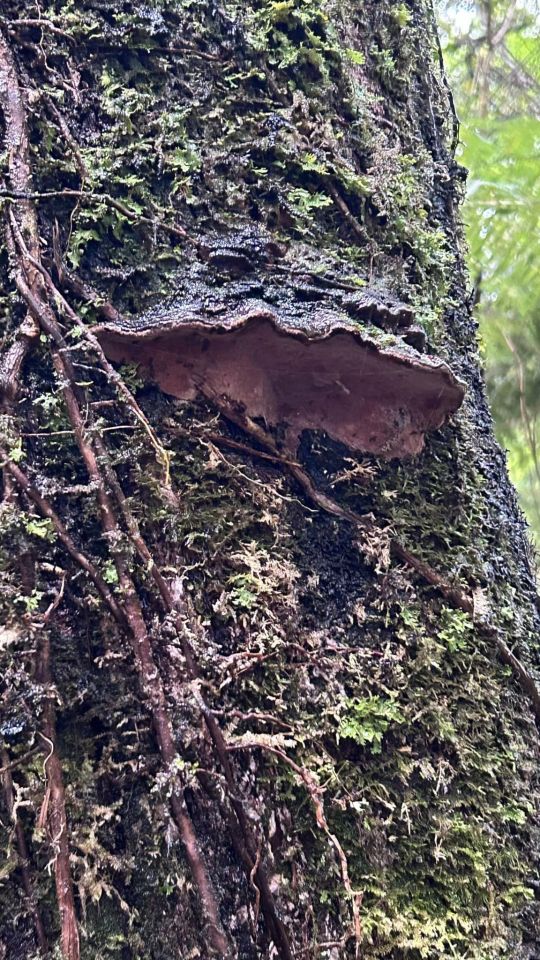
Spotted by @purrdence while she was looking at Lord of the Rings locations.
AKA Polyporus zealandicus, Fomes robinsoniae,Trametes wahlbergii, Phellinus setulosus, Poria uncinat, Fomes senex var. hamatus, Poria victoria, Phellinus pomaceus, Fuscoporia uncinata, Fomes hamatus, Phellinus zealandicus, Fomes pomaceus, Polyporus victoriae, Scindalma zealandicum, Phellinus senex var. hamatus, Phellinus wahlbergii, Pyropolyporus robinsoniae and Fomes zealandicus. Some of that is no doubt due to genera being split up or renamed, but I suspect a good deal of it is due to mycologists discovering that what they thought were different species, scattered worldwide, were all the same thing. Pyropolyporus robinsoniae, for example, was only known from a single decaying tree in Jamaica.
That said, it has been showing up well outside its previous range in recent decades - Buckinghamshire in the UK for example, when its nearest known site was in the Canary Islands. It’s not clear why it’s only spreading now, but in the case of the UK sighting mentioned above, the fungus remains so rare and scattered that the spores probably blew in (possibly on dust from the Sahara) rather then arriving as an existing infection in an exotic plant or timber, and found the warmer weather to its liking.
This bracket fungus is still mostly a tropical/subtropical species with tough, woody fruitbodies up to 55 cm wide and 30 cm out from the tree. It infects a wide range of host trees.
3 notes
·
View notes
Text










Wild Fungi Finds from my walk today :) first fungus fruitbody I dont recall species. Second is a soikey puffball and last seems to be Inkstain Bolete :)
.
.
.
Follow for more!
(linktr.ee/mycochaotix)
#fungi#fungus#fungifinds#mycology#lgbtqia2s#magic mushies#microbiology#mold#60s psychedelia#lgbtqia#lgbtqia2s+#myc#enby#funthey#funthem#nb#gay#mycelium
3 notes
·
View notes
Text
u/Scrybal commented on a comment I made, quoting my: “dice roll of spore germination”
Their comment: “ I've read a lot of posts and comments on the sub and have literally never come across this phrase. I have no idea what to make of it. I didn't even know that it was possible to have a stagnant strain. What is a stagnant strain? “
Mycochaos response:
Spore germination is absolutely a dice roll, and a huge one with multi-variant possibilities, at that. Not just genetically when two spores do actually mate... but also related to the sterility of the water that multi-spore syringes have spores suspended in... and then there is the fact that you can have a clump of spores and none of the spores touching each other (without aid of zig-zag inoculation loop across petri dish) that just simply dont germinate with each other and just stay a clump of spores.
When I say stagnant strains I literally mean spore germination that leads to growth characteristics and/or genetic issues that cause its metabolism to cease, or slow to the point of competitor contaminants taking over uncolonized nutrients before the slowed or stalled or ametabolic mycelium)
The Mushroom Cultivator, Stamets and Chilton explains (page 5-14) the following related to lifecycle of basidiomycetes:
"
In the life cycle of the mushroom plant, the fruitbody occurs briefly. The mycelial network can sit dormant for months, sometimes years and may only produce a single flush of mushrooms. During those few weeks of fruiting, the mycelium is in a frenzied state of growth, amassing nutrients and forming dense ball-like masses called primorida that eventually enlarge into the towering mushroom structure. The gills first develop from the tissue on the underside of the cap, appearing as folds, then becoming blunt ridges and eventually extending into flat, vertically aligned plates. These efficiently arranged symmetrical gills are populated with spore producing cells called basidia.
From a structural point of view, the mushroom is an efficient reproductive body. The cap acts as a domed shield protecting the underlying gills from the damaging effects of rain, wind and sun. Covering the gills in many species is a well developed layer of tissue called the partial veil which extends from the cap margin to the stem. Spores start falling from the gills just before the partial veil tears. After the partial veil has fallen, spores are projected from the gills in ever increasing numbers.
The cap is supported by a pillar-like stem That elevates the gills above ground where the spores can be carried off by the slightest wind currents. Clearly, every part of the mushroom fruitbody is designed to give the spores the best opportunity to mature and spread in an external environment that is often harsh and drastically fluctuating. As the mushroom matures, spore production slows and eventually stops. At this time mushrooms are in their last hours of life. Soon decay from bacteria and other fungi sets in, reducing the once majestic mushroom into a soggy mass of fetid tissue that melts into the ground from which it sprung.
Most mushrooms produce spores that are uninucleate and genetically haploid (1N). This means each spore contains one nucleus and has half the complement of chromosomes for the species. Thus spores have a "sex" in that each has to mate with mycelia from another spore type to be fertile [thus to germinate] for producing offspring. When spores are first released they are fully inflated "moist" cells that can easily germinate. Soon they dehydrate, collapsing at their centers and in this phase they can sit dormant Through long periods of dry weaTher or severe drought. When weather conditions provide a sufficiently moist environment, the spores rehydrate and fully inflate. Only then is germination possible.
Spores within an individual species are fairly constant in their shape and structure. However, many mushroom species differ remarkably in their spore types. Some are smooth and lemon shaped (in the genus Copelandia, for instance); many are ellipsoid (as in the genus Psilocybe); while others are highly ornamented and irregularly shaped (such as (hose in Lactarius or Entoloma}. A feature common to the spores of many mushrooms, particularly the psilocybian species, is the formation of an apical germ pore.
The germ pore, a circular depression at one end of the spore, is the site of germination from which a haploid strand of mycelium called a hypha emanates. This hypha continues to grow, branches and becomes a mycelial network. When two sexually complementary hyphal networks intercept one another and make contact, cell walls separating the two hyphal systems dissolve and cytoplasmic and genetic materials are exchanged. Erotic or not, this is "mushroom sex". Henceforth, all resulting mycelium is binucleate and dikaryotic. This means each cell has two nuclei and a full complement of chromosomes. With few exceptions, only mated (dikaryotic) mycelia is fertile and capable of producing fruitbodies. Typically, dikaryotic mycelia is faster running and more vigorous than unmated, monokaryotic mycelia. Once a mycelium has entered into the dikaryophase, fruiting can occur shortly thereafter. In Psilocybe cubensis, the time between spore germination and fruitbody initials can be as brief as two weeks; in some Panaeolus species only a week transpires before mushrooms appear. Most mushroom species, however, take several weeks or months before mushrooms can be generated from the time of spore germination.
Cultivators interested in developing new strains by crossing single spore isolates take advantage of the occurrence of clamp connections to tell whether or not mating has taken place. Clamp connections are microscopic bridges that protrude from one adjoining cell to another and are only found in dikaryotic mycelia. Clamps can be readily seen with a light microscope at 100-400X magnification. Not all species form clamp connections. (Agaricus brunnescens does not; most all Psilocybe and Panaeolus species do). In contrast, mycelia resulting from haploid spores lack clamps. This feature is an invaluable tool for the researcher developing new strains.
Two dikaryotic mycelial networks can also grow together, exchange genetic material and form a new strain. Such an encounter, where two hyphal systems fuse, is known as anastomosis. When two incompatible colonies of mycelia meet, a zone of inhibited growth frequently forms. On agar media, this zone of incompatibility is visible to the unaided eye.
"
#mycology#myco#mushroom#mycochaos#mycochaotix#gay#lgbt#stamets#nature#art#love#basidio#basidiomycota
3 notes
·
View notes